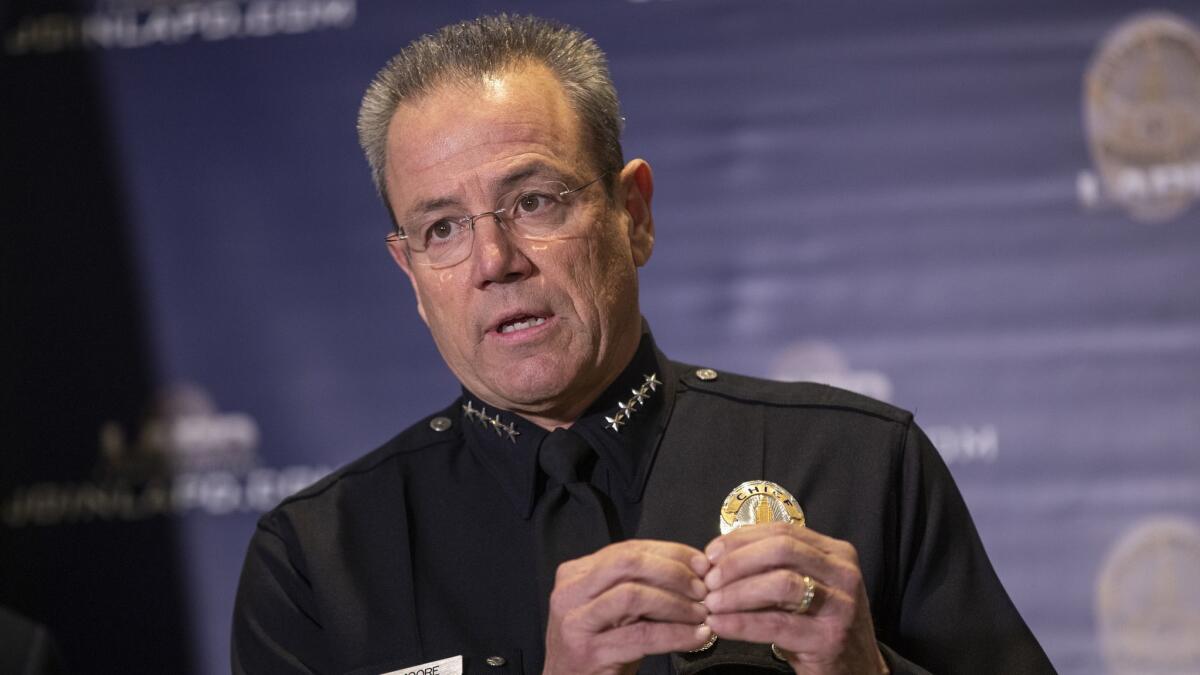LAPD records drop in shootings by officers

- Share via
The use of deadly force by Los Angeles police and the number of suspects killed in violent encounters dropped in 2018, officials reported Tuesday.
Los Angeles police officers fired their weapons 33 times last year compared with 44 shootings the previous year — a 25% decrease, according to the report presented to the Police Commission. It’s the second-fewest incidences of police shootings since 1989, the report said.
For the record:
8:40 p.m. April 22, 2019A previous version of this article stated that in 2018, the Los Angeles Police Department led the nation in fatal shootings by officers with 14. A report released last week by the National Police Foundation said that the Phoenix Police Department was involved in 23 fatal shootings by officers last year. In its report on the use of force, the LAPD compared numbers of fatal shootings by several large police departments, but it did not Phoenix.
Of the 33 shootings, 24 people were hit by gunfire. The 14 people who died represented a slight drop from 17 the previous year. Fatal shootings have fallen each year since officers killed 21 people in 2015, the department said.
Of those fatally shot, eight were Latinos, one was white and the ethnicity of one person was not listed. Four African Americans were fatally shot in officer-involved incidents last year, but two of those deaths were from self-inflicted gunshot wounds, the report said. Nearly 90% of those shot by police last year were armed with a firearm or other weapon.
“I’m encouraged by the results from last year,” Police Chief Michel Moore told the commission. “The greatest outcome is to safely resolve dangerous situations.”
Moore credited the reduction to new policies, additional training and body cameras worn by patrol officers. The department, he said, is working to be more transparent by releasing videos of shootings within 45 days of incidents. Building community partnerships is also creating more trust between police and residents, he said.
The Police Commission, the civilian panel that oversees the department, adopted policy changes in recent years requiring officers whenever possible to de-escalate situations before resorting to bullets. That can mean keeping a distance and taking more time to let encounters evolve by talking to people or requesting more resources.
The commission reviewed an executive summary Tuesday and plans to evaluate the entire report and address additional questions to Moore next week. Members of the panel praised the reductions but said the LAPD has room to improve.
“That is a very good thing,” said Commissioner Eileen Decker, who noted the LAPD provides more information on officer shootings than other big cities. “That doesn’t say the report is perfect.”
Commissioner Dale Bonner pressed police to explain the checks and balances used so the public can rely on the accuracy of the figures.
Capt. Jonathan Tom, leader of the Critical Incident Review Division, said the department uses a “very rigorous process” to extract data and requires supervisors to perform manual checks. Moore said he would welcome the inspector general to audit the process.
More people were shot and killed by police in Los Angeles than in Chicago, Philadelphia, New York and Houston, according to the report. Chicago, for example, recorded 32 shootings with six deaths.
The Los Angeles County Sheriff’s Department logged 22 shootings and had the second-highest death count with nine. Five people died in 17 shootings by the New York Police Department.
The LAPD says it made more than 1.7 million contacts with the public last year. Of those, slightly more than 2,100 resulted in any type of force used. Attacks on officers rose by 6% in 2018 from the previous year, according to the report.
Nationwide, police shootings, especially of young black and Latino men, have continued to be a flashpoint for activists, community members and the families of those killed.
More than a dozen relatives of Bryan Alexander Rodriguez attended Tuesday’s meeting. Police fatally shot the 29-year-old on May 30 in Pacoima. He threw bricks at officers and grabbed a pickax, the department said. His family told commissioners that Rodriguez suffered from mental health issues and questioned why officers didn’t do more to defuse the situation.
Another man in the audience stood silently and ripped up pages of the report, then threw it on the ground.
Other critics told commissioners there were fewer shootings because residents had brought attention to the issue.
They repeatedly cited last year’s shooting of Grechario Mack, a 30-year-old black man who was killed in April at the Baldwin Hills Crenshaw Plaza. According to police accounts, when Mack wouldn’t drop a knife, two officers shot him. After he fell to the ground and tried to get up with the knife, each officer fired another bullet. The commission ruled last month that the last round fired by each of the officers violated department policy on deadly use of force.
“The public said, ‘You can’t kill us without public accountability and consequences,’” Greg Akili, director of the social justice group the Fannie Lou Hamer Institute said while pointing at the panel.
More to Read
Sign up for Essential California
The most important California stories and recommendations in your inbox every morning.
You may occasionally receive promotional content from the Los Angeles Times.











